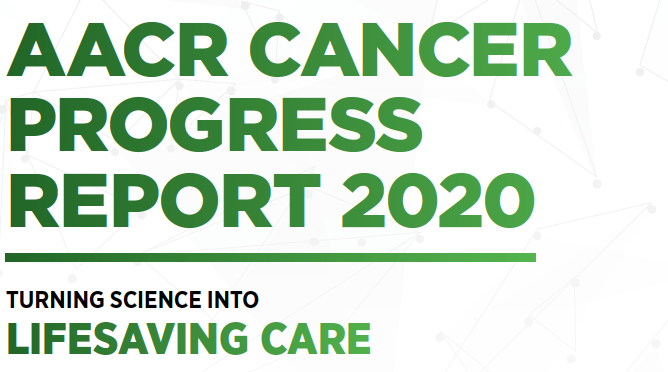Annual cancer progress report issued by the American association for cancer research
Turning science into lifesaving care
The American Association for Cancer Research (AACR) released its annual Cancer Progress Report, which highlights advances over the past year in the prevention, detection, diagnosis, and treatment of cancer. Below is a brief summary of this report.
Cancer in 2020
- In the United States, the overall cancer death rate has been steadily decreasing since the 1990s, with the reductions by 29 percent from 1991 to 2017 translating into more than 2.9 million cancer deaths avoided. The decline in the overall cancer death rate is being fueled in large part by a dramatic decrease in the lung cancer death rate predominantly as a result of reduced smoking rates.
- During the 2013 to 2017 period, the death rate for melanoma, which is the deadliest type of skin cancer, also fell at a remarkable rate of 6.4 percent each year. This striking reduction has been attributed in large part to the innovative new therapeutics approved by the U.S. Food and Drug Administration (FDA) for treating certain patients with this disease since 2011.
- Research continues to be the best defense against cancer because it is the driving force behind all clinical and policy advances that improve cancer prevention, detection, diagnosis, treatment, and, increasingly, cures for individuals around the world.
- The U.S. 5-year relative survival rate for all cancers combined rose from 49 percent for people diagnosed in the mid-1970s to 70 percent for those diagnosed from 2010 to 2016. The 5-year relative survival rate for all cancers diagnosed among U.S. children and adolescents (ages 0–19) from 2010 to 2016 was 85 percent, up from 63 percent for those diagnosed in the mid-1970s.
- The increasing personal and economic burden of cancer highlights the vital need for more transformative research to accelerate the pace of progress. The public health challenge posed by cancer will grow considerably in the United States and around the world in the coming decades unless improved strategies for cancer prevention, early detection, and treatment are developed and effectively implemented.
- In 2020, making further inroads against cancer has been further complicated by the Coronavirus Disease 2019 (COVID-19) pandemic. As one example, it is estimated that there will be at least 10,000 additional deaths from breast cancer and colorectal cancer over the next decade in the United States as a result of the adverse effect of the COVID-19 pandemic on screening and treatment for these two types of cancer.
Understanding How Cancer Develops
- Research provides our understanding of the biology of cancer, which is not one disease, but a collection of diseases characterized by the uncontrolled growth of cells.
- Genetic mutations underpin cancer initiation and development in most cases; the mutations are inherited in about 10 percent of cancer cases.
- Each person’s cancer has a unique combination of mutations, and as cancer cells divide, new mutations arise in the daughter cells. Thus, a tumor is made up of a collection of cancer cells with a wide range of genetic abnormalities. This variation in cell types, also known as heterogeneity, is an important part of a cancer’s characteristics and fuels the cancer’s ability to grow faster, escape therapy, evade the immune system, and metastasize to other organs.
- Not all mutations acquired by a cell lead to cancer. In fact, the genes that are mutated, and the order and speed at which a cell acquires mutations, determine whether a cancer will develop and, if a cancer does develop, the length of time it will take to happen.
- Cancer initiation and progression are strongly influenced by interactions among cancer cells and cellular and molecular factors in their environment, referred to as the tumor microenvironment.
- The more we know about the contributions of the numerous individual factors and their interplay in influencing cancer development among all populations, the more precisely and effectively we can prevent and treat cancer.
- Precision medicine aims to use genetic and other information about a patient’s tumor, as well as other factors, to help diagnose, plan treatment, determine how well treatment is working, or make a prognosis, with the overarching goal of improving clinical outcomes and minimizing unnecessary diagnostic and therapeutic interventions.
Preventing Cancer: Identifying Risk Factors
- In the United States, four out of 10 cancer cases and almost half of all cancer-related deaths are associated with preventable risk factors.
- Tobacco use is the leading preventable cause of cancer because it exposes individuals to many harmful chemicals that damage DNA, causing genetic and epigenetic alterations that lead to cancer development. Smoking tobacco has been shown to increase the risk of developing 17 different types of cancer in addition to lung cancer. Fortunately, quitting at any age can reduce these risks.
- Nearly 20 percent of new cancer cases and 16 percent of cancer deaths in U.S. adults are attributable to a combination of being overweight or obese, poor diet, physical inactivity, and excessive alcohol consumption. Being overweight or obese as an adult increases a person’s risk for 15 types of cancer whereas being physically active reduces risk for nine types of cancer. According to a recent report, being inactive for 13 or more hours per day can increase the risk of dying from cancer by 82 percent. Another research shows that replacing just 30 minutes of sedentary behavior with a moderately intense physical activity such as biking can reduce the risk of dying from cancer by 30 percent. Drinking alcohol increases the risk for six different types of cancer.
- Many cases of skin cancer could be prevented by protecting the skin from ultraviolet radiation from the sun and indoor tanning devices. All three main types of skin cancer – basal cell carcinoma, squamous cell carcinoma, and melanoma, the deadliest form of skin cancer – are largely caused by exposure to UV radiation from the sun or indoor tanning devices. In fact, more than 90 percent of the total cases of melanoma during 2011–2015 in the United States were attributable to UV exposure. Sunburn, a clear indication of overexposure to UV radiation, is a preventable risk factor for skin cancer and those events occurring in childhood pose the greatest risk.
- The primary causes of infection-attributable cancers are human papillomavirus (HPV), hepatitis B virus (HBV), hepatitis C virus (HCV), and Helicobacter pylori. Nearly all cases of cervical cancer could be prevented by HPV vaccination.
- In addition to epidemiological data on increasing incidence or death from cancers, emerging mechanistic studies indicate how cancer risk factors such as obesity, smoking, and other factors can influence disease subtype, aggressiveness, and outcomes through their effects on cancer cells and/or the tumor microenvironment including immune cells.
Screening for Early Detection
- Research identifying how cancer arises and progresses has led to the development of screening tests that can be used for early detection of cancer and precancerous lesions.
- Screening for cancer means checking for precancerous lesions or cancer in people who have no signs or symptoms of the cancer for which they are being checked. The aim is to find an abnormality at the earliest possible time in cancer development.
- Screening for cancer has many benefits, including reducing the likelihood of an individual being diagnosed with the screened cancer at an advanced stage and of dying from the screened cancer. However, screening for cancer also has the potential to cause unintended harms, which is why it is not recommended for everyone.
- Every person has a unique risk for each type of cancer based on genetic, molecular, and cellular makeup, lifetime exposures to cancer risk factors, and general health.
Turning Science into Lifesaving Care
- Research discoveries that have been made as a result of innovative cancer science are continually being translated to new medical products for cancer prevention, detection, diagnosis, treatment, and survivorship.
- Between August 1, 2019 and July 31, 2020, 20 new anticancer therapeutics were approved by the FDA for introduction into the clinic. In addition, during this period, the FDA expanded the uses of 15 previously approved anticancer therapeutics to include additional types of cancer.
- Five vital pillars of clinical cancer care include surgery, radiotherapy, cytotoxic chemotherapy, molecular targeted therapy, and immunotherapy.
- In the past decade, cancer immunotherapy emerged as the fifth pillar of cancer care. It is one of the most exciting approaches to cancer treatment to have ever entered the clinic. This is in part because some of the patients with metastatic disease who have been treated with these revolutionary treatments have had remarkable and durable responses. Unfortunately, only a minority of patients have incredible responses to immunotherapy. In addition, the current FDA-approved immunotherapeutics do not work against all types of cancer. Identifying ways to increase the number of patients for whom treatment with an immunotherapeutic yields a remarkable and durable response is an area of intensive basic and clinical research investigation.
- As of July 31, 2020, there are seven checkpoint inhibitors approved by the FDA. This means that one or more checkpoint inhibitor were approved for treating 16 types of cancer and for treating any type of solid tumor characterized by the presence of certain molecular characteristics.
- Even though checkpoint inhibitors have yielded extraordinary benefit for patients with a diverse array of cancer types, not all patients have tumors that respond to these immunotherapeutics and many whose tumors do respond, initially, develop resistance after a while. Therefore, researchers are working hard to determine how to increase the number of patients who benefit from these lifesaving immunotherapeutics.
- One of the most recently developed ways to dramatically increase the number of functional cancer-killing T cells that a patient has is an approach to immunotherapy called adoptive T-cell therapy. Adoptive T-cell therapy is a complex medical procedure that is customized for each patient. During treatment, T cells are harvested from a patient, expanded in number and/or genetically modified in the laboratory, and then returned to the patient, where they attack and potentially eliminate the cancer cells.
- Details on novel drug approvals by FDA may be found in the full report: https://bit.ly/33O8imS.
LOOKING TO THE FUTURE
- Cutting-edge technologies that fuel the full spectrum of cancer science from bench to bedside will accelerate the pace at which we increase our understanding of cancer biology while transforming the future of clinical practice.
- As researchers accumulate large quantities of patient data, artificial intelligence approaches, such as machine learning programs have the potential to help us analyze these vast amounts of health care information to derive meaningful insights we previously could not have realized.
- Liquid biopsies have the potential to transform early detection, diagnosis, and treatment of cancer in the future.
- Our scientific understanding of the immune system and how it interacts with cancer cells is rapidly increasing, and numerous clinical trials are underway that are testing many novel immunotherapeutics and new ways to use those immunotherapeutics that we already have.
—-
In conclusion, medical research is driving the innovation that is required to make progress against the more than 200 diseases we call cancer. More triumphs are yet to come. Stay tuned!
Source: cancerprogressreport.org; Philadelphia: American Association for Cancer Research, 2020

